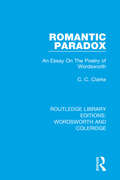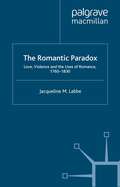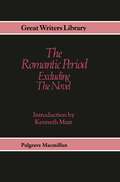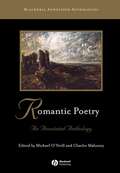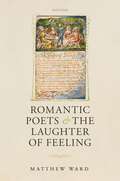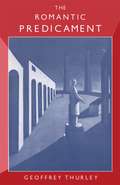- Table View
- List View
Romantic Paradox: An Essay on the Poetry of Wordsworth (RLE: Wordsworth and Coleridge)
by C.C. ClarkeFirst published in 1962, this book reveals unexpected complexity or equivocation in Wordsworth’s use of certain key words, particularly ‘image’, ‘form’ and ‘shape’. The author endeavours to show that this complexity is related to the poet’s awareness of the ambiguity of the perceptual process. Numerous passages from The Prelude and other poems are analysed to illustrate the argument and to show that, because of this doubt or hidden perplexity, Wordsworth’s poetry has a far richer texture, is more concentrated, intricately organised and loaded with ambivalent meanings than it would otherwise have been. New light is also shed on Wordsworth’s debt to Akenside.
Romantic Paradox: An Essay on the Poetry of Wordsworth (RLE: Wordsworth and Coleridge)
by C.C. ClarkeFirst published in 1962, this book reveals unexpected complexity or equivocation in Wordsworth’s use of certain key words, particularly ‘image’, ‘form’ and ‘shape’. The author endeavours to show that this complexity is related to the poet’s awareness of the ambiguity of the perceptual process. Numerous passages from The Prelude and other poems are analysed to illustrate the argument and to show that, because of this doubt or hidden perplexity, Wordsworth’s poetry has a far richer texture, is more concentrated, intricately organised and loaded with ambivalent meanings than it would otherwise have been. New light is also shed on Wordsworth’s debt to Akenside.
The Romantic Paradox: Love, Violence and the Uses of Romance, 1760-1830
by J. LabbeWhy are there so few 'happily ever afters' in the Romantic-period verse romance? Why do so many poets utilise the romance and its parts to such devastating effect? Why is gender so often the first victim? The Romantic Paradox investigates the prevalence of death in the poetic romances of the Della Cruscans, Coleridge, Keats, Mary Robinson, Felicia Hemans, Letitia Landon, and Byron, and posits that understanding the romance and its violent tendencies is vital to understanding Romanticism itself.
The Romantic Period: The Intellectual & Cultural Context of English Literature 1789-1830 (Longman Literature In English Series)
by Robin JarvisThe Romantic Period was one of the most exciting periods in English literary history. This book provides a comprehensive and up-to-date account of the intellectual and cultural background to Romantic literature. It is accessibly written and avoids theoretical jargon, providing a solid foundation for students to make their own sense of the poetry, fiction and other creative writing that emerged as part of the Romantic literary tradition.
The Romantic Period: The Intellectual & Cultural Context of English Literature 1789-1830 (Longman Literature In English Series)
by Robin JarvisThe Romantic Period was one of the most exciting periods in English literary history. This book provides a comprehensive and up-to-date account of the intellectual and cultural background to Romantic literature. It is accessibly written and avoids theoretical jargon, providing a solid foundation for students to make their own sense of the poetry, fiction and other creative writing that emerged as part of the Romantic literary tradition.
Romantic Poetry: An Annotated Anthology (pdf) (Blackwell Annotated Anthologies Ser. #5)
by Michael O'Neill Charles MahoneyEasily adaptable as both an anthology and an insightful guide to reading and understanding Romantic Poetry, this text discusses the important elements in the works from poets such as Smith, Blake, Wordsworth, Coleridge, Southey, Barbauld, Byron, Shelley, Hemans, Keats and Landon. Offers a thorough examination of the essential elements of Romantic Poetry Highly selective, the text examines each of its poems in great detail Discusses theme, genre, structure, rhyme, form, imagery, and poetic influence Helpful head notes and annotations provide relevant contextual information and in-depth commentary
Romantic Poetry and Literary Coteries: The Dialect of the Tribe (Nineteenth-Century Major Lives and Letters)
by Tim FulfordCombining historical poetics and book history, Romantic Poetry and Literary Coteries shows Romanticism as characterized by tropes and forms that were jointly produced by literary circles. To show these connections, Fulford pulls from a wealth of print material including political squibs, magazine essays, illustrated tour poems, and journals.
The Romantic Poetry Handbook (Wiley Blackwell Literature Handbooks)
by Michael O'Neill Madeleine CallaghanAn absorbing survey of poetry written in one of the most revolutionary eras in the history of British literature This comprehensive survey of British Romantic poetry explores the work of six poets whose names are most closely associated with the Romantic era—Wordsworth, Coleridge, Blake, Keats, Byron, and Shelley—as well as works by other significant but less widely studied poets such as Leigh Hunt, Charlotte Smith, Felicia Hemans, and Letitia Elizabeth Landon. Along with its exceptional coverage, the volume is alert to relevant contexts, and opens up ways of understanding Romantic poetry. The Romantic Poetry Handbook encompasses the entire breadth of the Romantic Movement, beginning with Anna Laetitia Barbauld and running through to Thomas Lovell Beddoes and John Clare. In its central section ‘Readings’ it explores tensions, change, and continuity within the Romantic Movement, and examines a wide range of individual poems and poets through sensitive, attentive and accessible analyses. In addition, the authors provide a full introduction, a detailed historical and cultural timeline, biographies of the poets whose works are featured in the “Readings” section, and a helpful guide to further reading. The Romantic Poetry Handbook is an ideal text for undergraduate and postgraduate study of British Romantic poetry. It also will appeal to every reader with an interest in the Romantics and in poetry generally.
The Romantic Poetry Handbook (Wiley Blackwell Literature Handbooks)
by Michael O'Neill Madeleine CallaghanAn absorbing survey of poetry written in one of the most revolutionary eras in the history of British literature This comprehensive survey of British Romantic poetry explores the work of six poets whose names are most closely associated with the Romantic era—Wordsworth, Coleridge, Blake, Keats, Byron, and Shelley—as well as works by other significant but less widely studied poets such as Leigh Hunt, Charlotte Smith, Felicia Hemans, and Letitia Elizabeth Landon. Along with its exceptional coverage, the volume is alert to relevant contexts, and opens up ways of understanding Romantic poetry. The Romantic Poetry Handbook encompasses the entire breadth of the Romantic Movement, beginning with Anna Laetitia Barbauld and running through to Thomas Lovell Beddoes and John Clare. In its central section ‘Readings’ it explores tensions, change, and continuity within the Romantic Movement, and examines a wide range of individual poems and poets through sensitive, attentive and accessible analyses. In addition, the authors provide a full introduction, a detailed historical and cultural timeline, biographies of the poets whose works are featured in the “Readings” section, and a helpful guide to further reading. The Romantic Poetry Handbook is an ideal text for undergraduate and postgraduate study of British Romantic poetry. It also will appeal to every reader with an interest in the Romantics and in poetry generally.
The Romantic Poets (Blackwell Guides to Criticism)
by Uttara NatarajanThis welcome addition to the Blackwell Guides to Criticism series provides students with an invaluable survey of the critical reception of the Romantic poets. Guides readers through the wealth of critical material available on the Romantic poets and directs them to the most influential readings Presents key critical texts on each of the major Romantic poets – Blake, Wordsworth, Coleridge, Byron, Shelley and Keats – as well as on poets of more marginal canonical standing Cross-referencing between the different sections highlights continuities and counterpoints
Romantic Poets and the Laughter of Feeling
by Matthew WardThe Romantic period witnessed decisive interest in how feeling might align with forms of artistic expression. Many critical studies have focused on the serious side and melancholic moods of Romantic poets. Romantic Poets and the Laughter of Feeling instead embraces the sublime and the ridiculous to offer an original and compelling new reading of British Romanticism. It reveals the decisive role laughter and the laughable play in Romantic aesthetics, emotions, and ethics. Matthew Ward shows that laughter was one of the primary means by which Romantics embraced and expanded upon, but also frequently aped and lampooned, sympathetic feeling. The laughter of feeling is both the expression of sympathy and an articulation of its implications, prejudices, and constraints. For Romantic poets like Wordsworth, Shelley, and Keats, the sound of laughter carries the hope that greater knowledge of others derives from feeling for and with them through poetry, and this might lead to a better understanding of oneself. Yet laughter also makes these poets acutely aware that our emotional lives are utterly unfamiliar and perhaps ultimately unknowable. Their prosody of laughter enlivens and exposes; it embodies their sense of?and ambitions for?poetry, and yet calls those matters into the most comical and gravest doubt. Laughter helps define what it is to be human. This book shows that it also defines what it is to be a 'Romantic' poet.
Romantic Prayer: Reinventing the Poetics of Devotion, 1773-1832
by Christopher StokesWhilst religion and the secular have been continually debated contexts for literature of the Romantic era, the dominant scholarly focus has been on doctrines and denominations. In analysing the motif of devotion, Romantic Prayer shifts attention to the quintessential articulation of religion as lived experience, as practice, and as a performative rather than descriptive phenomenon. In an era when the tenability and rationality of prayer was much contested, poetry—a form with its own interlinked history with prayer—was a unique place to register what prayer meant in modernity. This study illustrates how the discourse of prayer continually intervened in the way that poetic practices evolved and responded to the religious and secular questions of the eighteenth and nineteenth-century moment. After laying out the details of prayer's historical position in the Romantic era across a spread of religious traditions, Romantic Prayer turns to a range of writers, from the identifiably religious to the staunchly sceptical. William Cowper and Anna Letitia Barbauld are shown to use poetry to reflect and reinvent the ideals of prayer inherited from their own denominational histories. Samuel Taylor Coleridge's work is analysed as part of a long engagement with the rationality of prayer, culminating in an explicit 'philosophy' of prayer; William Wordsworth—by contrast—keeps prayer at an aesthetic distance, continually alluding to prayerful language but rarely committing to devotional voice itself. John Keats, Percy Bysshe Shelley, and Lord Byron are treated in the context of departing from Christianity, under the influence of Enlightenment, materialist, and atheist critiques—what happens to prayer in poetry when prayer as a language traditionally conceived is becoming impossible to maintain?
Romantic Prayer: Reinventing the Poetics of Devotion, 1773-1832
by Christopher StokesWhilst religion and the secular have been continually debated contexts for literature of the Romantic era, the dominant scholarly focus has been on doctrines and denominations. In analysing the motif of devotion, Romantic Prayer shifts attention to the quintessential articulation of religion as lived experience, as practice, and as a performative rather than descriptive phenomenon. In an era when the tenability and rationality of prayer was much contested, poetry—a form with its own interlinked history with prayer—was a unique place to register what prayer meant in modernity. This study illustrates how the discourse of prayer continually intervened in the way that poetic practices evolved and responded to the religious and secular questions of the eighteenth and nineteenth-century moment. After laying out the details of prayer's historical position in the Romantic era across a spread of religious traditions, Romantic Prayer turns to a range of writers, from the identifiably religious to the staunchly sceptical. William Cowper and Anna Letitia Barbauld are shown to use poetry to reflect and reinvent the ideals of prayer inherited from their own denominational histories. Samuel Taylor Coleridge's work is analysed as part of a long engagement with the rationality of prayer, culminating in an explicit 'philosophy' of prayer; William Wordsworth—by contrast—keeps prayer at an aesthetic distance, continually alluding to prayerful language but rarely committing to devotional voice itself. John Keats, Percy Bysshe Shelley, and Lord Byron are treated in the context of departing from Christianity, under the influence of Enlightenment, materialist, and atheist critiques—what happens to prayer in poetry when prayer as a language traditionally conceived is becoming impossible to maintain?
Romantic Presences in the Twentieth Century
by Mark SandyConcerned with the intermingled thematic and formal preoccupations of Romantic thought and literary practice in works by twentieth-century British, Irish, and American artists, this collection examines the complicated legacy of Romanticism in twentieth-century novels, poetry, and film. Even as key twentieth-century cultural movements have tried to subvert or debunk Romantic narratives of redemptive nature, individualism, perfectibility, and the transcendence of art, the forms and modes of feeling associated with the Romantic period continue to exert a signal influence on the modern moment - both as a source of tension and as creative stimulus. As the essays here show, the exact meaning of the Romantic bequest may be bitterly contested, but it has been difficult to leave behind. The contributors take up a wide range of authors, including Virginia Woolf, F. Scott Fitzgerald, W. H. Auden, Doris Lessing, Seamus Heaney, Hart Crane, William Faulkner, Don DeLillo, and Jonathan Franzen. What emerges from this lively volume is a fuller picture of the persistence and variety of the Romantic period's influence on the twentieth-century.
Romantic Presences in the Twentieth Century
by Mark SandyConcerned with the intermingled thematic and formal preoccupations of Romantic thought and literary practice in works by twentieth-century British, Irish, and American artists, this collection examines the complicated legacy of Romanticism in twentieth-century novels, poetry, and film. Even as key twentieth-century cultural movements have tried to subvert or debunk Romantic narratives of redemptive nature, individualism, perfectibility, and the transcendence of art, the forms and modes of feeling associated with the Romantic period continue to exert a signal influence on the modern moment - both as a source of tension and as creative stimulus. As the essays here show, the exact meaning of the Romantic bequest may be bitterly contested, but it has been difficult to leave behind. The contributors take up a wide range of authors, including Virginia Woolf, F. Scott Fitzgerald, W. H. Auden, Doris Lessing, Seamus Heaney, Hart Crane, William Faulkner, Don DeLillo, and Jonathan Franzen. What emerges from this lively volume is a fuller picture of the persistence and variety of the Romantic period's influence on the twentieth-century.
The Romantic Prison: The French Tradition
by Victor H. Brombert"Prison haunts our civilization," writes Victor Brombert. "Object of fear, it is also a subject of poetic reverie." Focusing on French literature of the Romantic era, the author probes the manifold significance of imprisonment as symbol and metaphor of the human condition. His thematic exploration draws on a constellation of writers ranging from the Platonic and Christian traditions to the Existentialist generation. Professor Brombert points out that nineteenth- and twentieth-century literature endowed the prison image with unusual prestige, and he examines the historical and social reasons. After considering the influence of Pascal and of the myth of the Bastille, he closely analyzes the work of Borel, Stendhal, Victor Hugo, Nerval, Baudelaire, Huysmans, and Sartre, with excursions into texts by Byron, Dostoevsky, Kafka, Solzhenitsyn, Sade, and others. His approach reflects a concern with the interaction of literature, historiography, and popular myth. This imaginative treatment deepens our understanding of Romanticism and its favored themes. It offers fresh thoughts as well about modern man's dialectical tensions between oppression and inner freedom, fate and revolt, and the awareness of the finite and the longing for infinity. A wide-ranging conclusion speculates about the future of the prison theme in a world that has been threatened by extermination camps.Originally published in 1978.The Princeton Legacy Library uses the latest print-on-demand technology to again make available previously out-of-print books from the distinguished backlist of Princeton University Press. These editions preserve the original texts of these important books while presenting them in durable paperback and hardcover editions. The goal of the Princeton Legacy Library is to vastly increase access to the rich scholarly heritage found in the thousands of books published by Princeton University Press since its founding in 1905.
Romantic Readers: The Evidence of Marginalia
by H. J. JacksonWhen readers jot down notes in their books, they reveal something of themselves-what they believe, what amuses or annoys them, what they have read before. But a close examination of marginalia also discloses diverse and fascinating details about the time in which they are written. This book explores reading practices in the Romantic Age through an analysis of some 2,000 books annotated by British readers between 1790 and 1830.This period experienced a great increase in readership and a boom in publishing. H. J. Jackson shows how readers used their books for work, for socializing, and for leaving messages to posterity. She draws on the annotations of Blake, Coleridge, Keats, and other celebrities as well as those of little known and unknown writers to discover how people were reading and what this can tell us about literature, social history, and the history of the book.
Romantic Readers and Transatlantic Travel: Expeditions and Tours in North America, 1760–1840
by Robin JarvisWhy and how did people read literature on North America by explorers, travellers, emigrants, and tourists? This is the central question Robin Jarvis takes up as he addresses a significant gap in scholarship on travel writing: its contemporary reception. Referencing reviews in the periodical press, personal journals, letters, autobiographies, marginalia, and bibliographical evidence relating to the production, distribution, and reception of travel literature, Jarvis focuses especially on the ideas and perceptions of North America expressed by individuals who never visited the subcontinent. Among the issues Jarvis explores are what the British reception of North American travel narratives says about the ways in which the United States was imagined in the Romantic period; how poets such as Samuel Taylor Coleridge, Felicia Hemans, Robert Southey, and William Wordsworth, all voracious travel readers, incorporated their readings of travel books into their works; and the ways in which the reception of North American travel writing should be contextualized within the broader contours of British society and culture. Significantly, Jarvis differentiates between different communities of readers to show the extent to which class or professional status affected the way travel literature was read. Of equally crucial importance, he discusses the reception of travel literature on Canada and the Arctic as distinct from that on the United States. His book constitutes the most thorough exploration to date of the private reading experiences of travel literature during the Romantic period.
Romantic Readers and Transatlantic Travel: Expeditions and Tours in North America, 1760–1840
by Robin JarvisWhy and how did people read literature on North America by explorers, travellers, emigrants, and tourists? This is the central question Robin Jarvis takes up as he addresses a significant gap in scholarship on travel writing: its contemporary reception. Referencing reviews in the periodical press, personal journals, letters, autobiographies, marginalia, and bibliographical evidence relating to the production, distribution, and reception of travel literature, Jarvis focuses especially on the ideas and perceptions of North America expressed by individuals who never visited the subcontinent. Among the issues Jarvis explores are what the British reception of North American travel narratives says about the ways in which the United States was imagined in the Romantic period; how poets such as Samuel Taylor Coleridge, Felicia Hemans, Robert Southey, and William Wordsworth, all voracious travel readers, incorporated their readings of travel books into their works; and the ways in which the reception of North American travel writing should be contextualized within the broader contours of British society and culture. Significantly, Jarvis differentiates between different communities of readers to show the extent to which class or professional status affected the way travel literature was read. Of equally crucial importance, he discusses the reception of travel literature on Canada and the Arctic as distinct from that on the United States. His book constitutes the most thorough exploration to date of the private reading experiences of travel literature during the Romantic period.
Romantic Realities: Speculative Realism and British Romanticism (Speculative Realism)
by Evan GottliebSpeculative realism is one of the most exciting, influential and controversial new branches of philosophy to emerge in recent years. Now, Evan Gottlieb shows that the speculative realism movement bears striking a resemblance to the ideas and beliefs of the best-known British poets of the Romantic era. Romantic Realities analyses the parallels and echoes between the ideas of the most influential contemporary practitioners of speculative realism and the poetry and poetics of the most innovative Romantic poets. In doing so, it introduces you to the intellectual precedents and contemporary stakes of speculative realism, together with new understandings of the philosophical underpinnings and far-reaching insights of British Romanticism.
Romantic Realities: Speculative Realism and British Romanticism (Speculative Realism)
by Evan GottliebSpeculative realism is one of the most exciting, influential and controversial new branches of philosophy to emerge in recent years. Now, Evan Gottlieb shows that the speculative realism movement bears striking a resemblance to the ideas and beliefs of the best-known British poets of the Romantic era. Romantic Realities analyses the parallels and echoes between the ideas of the most influential contemporary practitioners of speculative realism and the poetry and poetics of the most innovative Romantic poets. In doing so, it introduces you to the intellectual precedents and contemporary stakes of speculative realism, together with new understandings of the philosophical underpinnings and far-reaching insights of British Romanticism.
The Romantic Reviewers: 1802-1824 (Routledge Library Editions: Romanticism)
by John O. HaydenFirst published in 1969. This study of literary reviewing in the early nineteenth century is concerned with contemporary criticism of the works of the major Romantic poets – Wordsworth, Coleridge, Byron, Shelley and Keats – and of seven other notable Romantic writers including Hazlitt, Lamb and Scott. The criticism of all works in prose and verse, excluding novels, published by these writers between 1802 and 1824 is described and analysed. This study also considers the policies and practices of the reviews, and their political, religious and moral attitudes in literary matters. This title will be of interest to students of literature.
The Romantic Reviewers: 1802-1824 (Routledge Library Editions: Romanticism)
by John O. HaydenFirst published in 1969. This study of literary reviewing in the early nineteenth century is concerned with contemporary criticism of the works of the major Romantic poets – Wordsworth, Coleridge, Byron, Shelley and Keats – and of seven other notable Romantic writers including Hazlitt, Lamb and Scott. The criticism of all works in prose and verse, excluding novels, published by these writers between 1802 and 1824 is described and analysed. This study also considers the policies and practices of the reviews, and their political, religious and moral attitudes in literary matters. This title will be of interest to students of literature.
